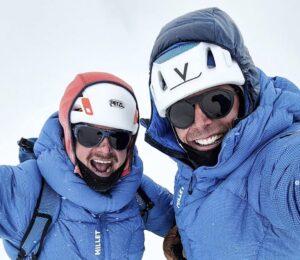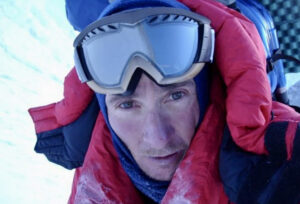During a lecture in a small mountain club in northern Spain yesterday, Denis Urubko mentioned that he wanted to climb Gasherbrum I this winter. Social media and news sites hurried to announce the upcoming expedition. But when we asked Urubko himself, he was less certain.
“I still have no money,” he admitted. “I was sharing a wish with the public, but nothing is confirmed.”
Urubko says he might have to decide at the very last minute.
Urubko and partner Pipi Cardell attempted a new route on Gasherbrum I this past summer. First, they summited the peak’s normal route for acclimatization. Then they launched two alpine-style pushes up a new route, but bad conditions forced them back both times, first from 6,400m and then from 6,750m.

Denis Urubko and Pipi Cardell in Pakistan last summer. Photo: Pipi Cardell
Urubko could indeed put together one of his minimalist expeditions quickly. Typically, just he and one partner go in pure alpine style. For such a veteran, there’s not a lot of organizing. However, money is always an issue for small teams focused on highly committed alpinism. Many sponsors these days rank social-media impact over alpine excellence. And the latest decision by Pakistan’s authorities isn’t helping.
No more winter discounts
This winter, for the first time in years, the Gilgit-Baltistan government has eliminated the winter discounts (up to 95%!) for permits to all peaks above 6,500m. Until now, winter royalty fees were largely symbolic. It was an attractive incentive for small teams, such as Goetler and Barmasse on Nanga Parbat last January, and also for the big winter K2 expeditions.
In Nepal, the peaks high enough to require a permit have an off-season 50% discount. This applies both to the summer (monsoon-affected) and winter seasons. Alex Txikon, heading to winter Annapurna with a sherpa team, will benefit from the cost savings.

Pipi Cardell on Gasherbrum I last summer. Photo: Denis Urubko
But with the new measure, climbing a Pakistani peak in winter will cost just as much as it does in summer. Pakistan has a $12,000 group fee for K2, and $9,500 for its other four 8,0000’ers — Nanga Parbat, Broad Peak, Gasherbrum I, and Gasherbrum II. The group fee covers up to seven members. Additional members must pay $3,000 each. These fees have risen by over 75% since 2020.

2023 Pakistan climbing fees.
Some Western outfitters told ExplorersWeb that further increases are expected in 2024, but there’s been no official announcement yet.
What is winter for Gasherbrum I?
Adam Bielecki and Janusz Golab of Poland first climbed winter Gasherbrum I on March 9, 2012. The date lies well within the calendar winter. However, Denis Urubko is a purist who insists on using meteorological winter, from December 1 until the end of February, to classify that climbing season. By this standard, Bielecki and Golab did an early spring ascent. Read more about the debate over winter climbing expeditions here.

Adam Bielecki on winter Gasherbrum I. Photo: Janusz Golab
Quiet season ahead
Ali Saltoro of Alpine Adventure Guides Pakistan told ExplorersWeb that currently, there is not a single application for 2024 winter expeditions on peaks above 6,500m.
“In the next few months, we only expect a handful of backcountry skiers,” Saltoro said.

Backcountry skiers in the Hispar-Biafo area. Photo: Alpine Adventure Guides Pakistan
Poland’s Maciej Kimel will climb in Pakistan next February, but not on the higher peaks. If all goes according to plan, he and Michal Krol will launch a second winter attempt on Trango Tower.
The teams heading for peaks lower than 6,500m only need to pay a trekking fee of $50 and an extra environmental fee of $150. Urubko himself used this kind of permit in winter 2022-23 when he climbed a new route on Koshar Gang, a 6,400m peak near Skardu. His partners on that climb were Anton Kravchenko, Andrew Shlyapnikov, and Max Berngard.

Denis Urubko and Ali Saltoro of Alpine Adventure Guides Pakistan last winter in Skardu, before Urubko climbed Koshar Gang. Photo: Ali Saltoro






